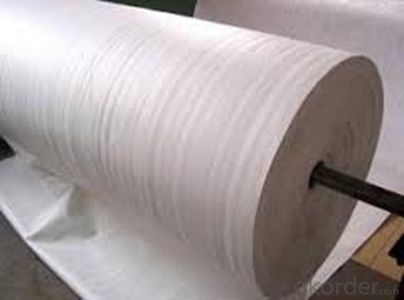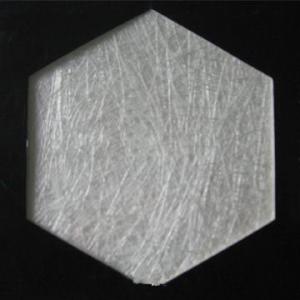Permeable Non-Woven Geotextile Fabric for Highway
- Loading Port:
- China main port
- Payment Terms:
- TT OR LC
- Min Order Qty:
- 5000 m²
- Supply Capability:
- 1000000 m²/month
OKorder Service Pledge
OKorder Financial Service
You Might Also Like
Specification
Product Introduction
woven manufacturers non woven fabric
1.high quality geotextiles
2.CE, ISO9001, ISO14001
3 Sample available
4. 100-800g/m2
If the selection of a larger melt index similar to the nonwoven fabric masterbatch melt index of the polymer is significantly higher than the polymer in order to ensure that the final product colors together. PE, PP woven masterbatch select LDPE (low density polyethylene) resin as the carrier, PS, ABS modified PS nonwoven masterbatch for the carrier selection.

Quality assurance
1.On a regular basis or as per your request,we entrust national testing agencies to conduct quality inspections
2. Strictly in accordance with the ISO9001-2008 international quality system standard,we monitor and manage the whole process throughout production,quality testing,and measurement to ensure product quality
3. For quality-related construction delay or substandard construction(except for damage or losses due to customer’s responsibility or irresistible natural disasters),we have refunding,replacement,and repair services.We will respond to customers’ feedbacks on quality issues within 24 hours.
FAQ:
Q: What kind of payments does jenor support?
A: T/T, L/C, Cash are accepted.
Q: Do you charge for the samples?
A: Accordeing to our company policy, the samples are free, we only charge the freight fee. And we will return the freight fee during the next order.
Q: Can you produce according to customers' design?
A: Sure, we are professional manufacturer, OEM and ODM are both welcome.
Q: Do you have other products?
A: Yes, please check the pictures:
Packaging & Shipping
Packing: PLASTIC FILM INSIDE, AND WOVEN BAG OUTSIDE
Shipping: About 15 days after receipt the deposit
geotextile fabric
permeability,filtration,easy for construction
ISO and CE certificate
Good quality and competitive price
- Q: What are the specifications for geotextiles in subsurface drainage projects?
- The specifications for geotextiles in subsurface drainage projects typically include requirements for the material's strength, permeability, filtration properties, and durability. These specifications ensure that the geotextile can effectively separate soil particles from the drainage media, prevent clogging, and maintain its functionality over time. Additionally, the specifications may also address the geotextile's dimensions, weight, and installation guidelines to ensure proper performance in subsurface drainage applications.
- Q: How do geotextiles help with sediment control in construction sites?
- Geotextiles help with sediment control in construction sites by acting as a barrier to prevent soil erosion and the migration of sediment. They are placed on the surface of the soil, where they allow water to pass through while trapping sediment particles. This helps to retain the soil in place and prevent it from being washed away by rainwater or other erosive forces. Geotextiles also aid in filtration by capturing suspended particles and allowing clean water to drain through, thus preventing sediment-laden runoff from reaching nearby water bodies.
- Q: What are the factors to consider when designing geotextile-reinforced structures?
- When designing geotextile-reinforced structures, several factors need to be considered. These factors include the type and properties of the geotextile material, the soil conditions and characteristics, the intended purpose and load requirements of the structure, the climate and environmental conditions, the construction and installation methods, and the long-term durability and maintenance considerations. By considering these factors, engineers can ensure the optimal design and performance of geotextile-reinforced structures.
- Q: What is the meaning of the process equipment and equipment for producing geotextiles?
- What is the meaning of the process equipment and equipment for producing geotextiles?
- Q: How do geotextiles help in reducing soil erosion caused by wind?
- Geotextiles help in reducing soil erosion caused by wind by creating a barrier that prevents the soil from being lifted and carried away by strong winds. It acts as a protective layer by stabilizing the soil, preventing its displacement and preserving its integrity.
- Q: Roof garden pool at the bottom with pebbles, pebbles above with geotextile, geotextile above the soil
- Should be installed drainage board it! Geotechnical material manufacturers to answer!
- Q: Can geotextiles be used in coastal protection systems?
- Yes, geotextiles can be used in coastal protection systems. They are commonly used for erosion control, shoreline stabilization, and beach nourishment projects. Geotextiles help to prevent soil erosion, filter sediment, and promote vegetation growth, making them an effective solution for coastal protection.
- Q: Can geotextiles be used in geosynthetic clay liner applications for containment systems?
- Yes, geotextiles can be used in geosynthetic clay liner applications for containment systems.
- Q: Geotextile puncture test standard
- Staple stitch filament piercing filament woven weaving
- Q: What does geotextile mean?
- Geotextile, also known as geotextile, it is made of synthetic fiber through acupuncture or woven from the permeability of geosynthetics. Geotextile is a new material geosynthetics which one, the finished product for the cloth, the general width of 4-6 meters, the length of 50-100 meters. Geotextile is divided into a spinning geotextile and non-woven filament geotextile. First, the characteristics: 1, high strength, due to the use of plastic fibers, in dry and wet state can maintain full strength and elongation. 2, corrosion-resistant, in different pH of the soil and water can be long-term corrosion resistance. 3, good water permeability between the fiber gap, it has a good water permeability. 4, good microbial resistance to micro-organisms, insects are not damaged. 5, construction convenience, as the material light, soft, so the delivery, laying, construction convenience. 6, complete specifications: width of up to 9 meters. Is currently the widest product, the unit area quality: 100-1000g / ㎡. Second, the role: 1, isolation 2, filtration 3, drainage 4, reinforced 5, protection 6, anti-puncture
Send your message to us
Permeable Non-Woven Geotextile Fabric for Highway
- Loading Port:
- China main port
- Payment Terms:
- TT OR LC
- Min Order Qty:
- 5000 m²
- Supply Capability:
- 1000000 m²/month
OKorder Service Pledge
OKorder Financial Service
Similar products
Hot products
Hot Searches
Related keywords


































